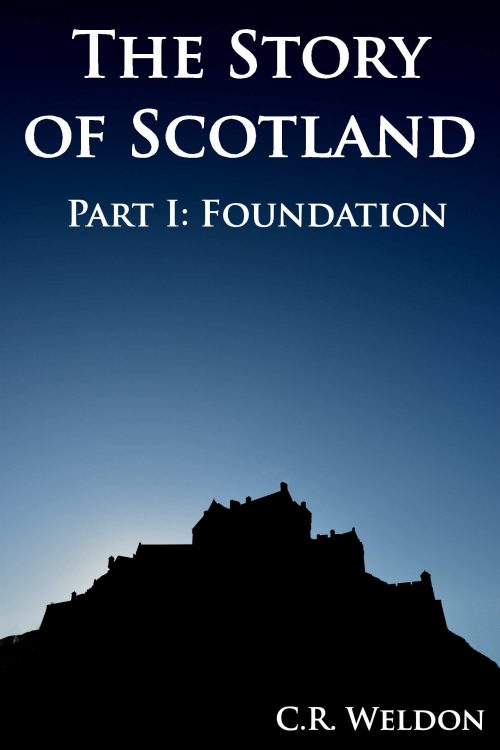The author says:
“In the north of Britain, a nation emerges. This is the story of how Scotland came to be – and of the family whose destiny was to rule it.”
This is a non-fiction history for a general readership, most of whom I guess will live in Scotland. I have split it into three books. (Part I covers up to the year 1513.) This allows me ship something faster, and gives me more opportunities to learn from feedback.
Most covers in the genre are either blue and white (the colour of the Scottish flag) or generically sepia toned. The classic of the genre, TM Devine’s ‘The Scottish Nation’, appears in both guises in different editions. This is about as close as I can get myself to a complete cover: all and any feedback gratefully received!
Nathan says:
This… is dull. And generic. From the font, to the silhouette, to the big chunk of empty space, there is nothing here that says “Scotland” except that word in the title. Even just overlaying a Scottish flag or a thistle across the sky would be something.
Also, readers of non-fiction are more accustomed to extra text on the cover than fiction readers. You’d get better mileage from something like this for the subtitle:
Part I: Foundation
From Prehistory to 1513
(“Prehistory” could be “The Legendary Past” or whatever phrase seems to encapsulate what you’ve written.)
Other comments?


Well, Nathan certainly nailed it when he called the cover “dull.” Aside from the blandness of the nearly monochromatic cover, there really isn’t a clue as to what the book is about.
I certainly wouldn’t depend upon a potential reader immediately recognizing the colors of the Scottish flag. You should not in any case depend upon a potential reader’s prior knowledge to make a cover work.
The fact that the covers for most other books on this subject are either blue and white or “generically sepia toned” is all the more reason to not go either route. You want your book to stand out in the crowd, not blend in.
Surely there are some historic images (most likely in the public domain) that would be more interesting, intriguing and informative than a silhouette of a castle? Do a Google image search with “large” and “image licensed for reuse” as your filters…and then double-check any image you like to make sure it is in fact free to use.
There is really no point in commenting on the typography since the cover image needs to be rethought entirely from scratch.
You’re starting in the right direction with looking at other covers in the genre and in using an iconic image that will be familiar to your audience–this is the silhouette of Edinburgh Castle, correct?
You haven’t gone far enough, though, You’re only looked at colors and fonts (I assume) when you should be looking at composition and images as well.
Here’s some Italian history books along with the Scottish one you mentioned (because I’m currently researching the Italian Renaissance for a writing project, not because I think the covers are really special).
Italy: A History. It’s a full-page close-up of part of the Colosseum, with big serif letters across the top. The title takes up close to 1/3 of cover.
A Concise History of Italy: green, red & white from the Italian flag, an Italian painting. Picture taking up lower 2/3, text in upper 1/3.
Devine’s The Scottish Nation 1700-2007. Flag colors, silhouette of raising the Scottish flag. Active part of image taking up middle 1/3 of cover, text on upper and lower thirds. The 1999 edition of the book has a less successful design using the same photo, but it still keeps close to the 2/3 text, 1/3 image guideline.
The Oxford Handbook of Modern Scottish History. Uses a Scottish painting. They have a brand look: relevant painting or other relevant object in top 2/3. bottom 1/3 black with title in complementary color to the image. Same font across all books.
Scottish History by Eric Brown. Uses this photo, treated it to look older. It fills 2/3 of the space, with the title in large letters up top.
These history books split the cover into thirds, and tend to have the text taking up 1/3 of the cover. If the image isn’t very big, the text takes up 2/3 of the cover. So you’re partway there: your title takes up 1/3, but the active part of the image takes up 1/3, and leaves the middle third as dead space.
You (generic “you” not specifically you) can’t use large expanses of flat color unless you’re really, really good at using negative space. It looks terrible. If you’re dead set on this specific photo then you need to increase the text.
However, there are thousands of lovely photos of Scotland available on inexpensive stock sites like Depositphotos. I would ABSOLUTELY NOT use ANY photo I found on Google that I did not pay for from a reputable site, because I have seen too many photos taken from stock sites and uploaded to random places and marked as “free for commercial use.” (Plus, the photographers really do deserve *something* for their effort.) You should also check that the site you purchase the image from requires their photographers to file property releases, because too many amateur photographers upload images of recognizable locations or artworks and don’t realize that the place requires you to purchase a license for commercial use of any photos. This link goes to a post I have on my site about why you shouldn’t use free stock photos, linked here only to keep this comment somewhat shorter and not to offer my services, as per our host’s rules.
Anyway! So here are six versions I produced after noodling around for half an hour or so. The top three would be if you were absolutely dead set on using that image
I’ll also note that I added to the subtitle, like our host, because I know when I’m looking for history, I want to know the time period a book covers. I didn’t reread your comment here so forgot that your book appears to be focusing on a single family, so your starting date would be something else. I’d also strongly suggest that if you *are* focusing on one family, that you put that in the subtitle.
The top 3 images are playing around with the 1/3-2/3 rule and moving the silhouette around, and filling in the triangle shape. None of them are looking particularly great to me, so I went in another direction for the bottom three. You’re in luck with nonfiction, because it’s pretty standard to have boxes separating the text from the cover image. I think a painting related to the subject of your book would be primo–maybe the family’s house/lands or a painting of one of them, if that exists, but paintings tend to be expensive to license (I used to be in charge of a slide collection in a school of architecture. They’re expeeeeensive). However, since I don’t know the family, I went with some other images of things and places in Scotland that seemed iconic, and that had interesting colors and textures to fill space up with.
I’m still not 100% happy with any of them. I think the white band on the bottom is too prominent, and I’d consider changing it to blue and your name to white. And not knowing the exact focus of your book, I couldn’t look for a specific building or landscape feature, as it would be my preference to do that.
Anyway, keep looking at other history books and see if you can figure out what things they have in common, and see if you can put them into your cover.
If anything, I’d think having the actual Scottish flag as the background for this (or any other) silhouette would be more effective. It’s worth remembering that Virginia’s battle flag from our USA’s Civil War (which has come to be identified in the popular imagination as the Confederacy’s flag, even though that rendition of St. Andrew’s Cross was actually only the canton on some of the Confederacy’s official flags) was somewhat based on that Scottish flag, and almost everybody here in America recognizes it almost instantly as a symbol of the Old South’s failed rebellion. While the Scottish flag is not as widely recognized here, I strongly doubt your stated target audience in Scotland (and perhaps the entire U.K.) will have any trouble recognizing it.
Simply having to ask the question “this is the silhouette of Edinburgh Castle, correct?” underscores one of the problems with the cover. It is meaningful only to those who are already familiar with the subject. This, I think, places a limit on the potential audience for the book.
That being said, the last three of the six examples posted by Augusta are superior in every way to those that employ the silhouette. While a potential reader may not recognize the specific locations, they at least convey a sense of antiquity and location—to say nothing of aesthetic appeal—that the silhouette absolutely fails to do. She is right about confining the title and author names to bands at the top and bottom: they would look better integrated into the cover image. But the last three examples are certainly on the right track.
Regarding RK’s suggestion about the Scottish flag, I would argue against it for the same reason I argue against the silhouette of Edinburgh Castle: it depends too much on a potential reader’s prior knowledge and familiarity. And even if your target audience is in Scotland or the entire UK, it doesn’t necessarily convey the idea of history, only location.
Ditto–I agree with Ron’s comments here. I rather like Augusta’s composition in the center bottom; it also provides color/contrast, and to my thinking, anyway, draws the eye as do none of the others, particularly the top row which yes, is uber-bland. And, sorry, submitter, boooooring. Even Augusta’s work didn’t salvage it.
Everybody has already covered anything I’d say; typography also needs to be addressed, but as Augusta has demonstrated, with the right image and composition, you can even use pretty bog-standard fonts and it’ll work.
Thank you so much all for your detailed, thoughtful criticism, especially Augusta. I’ve shown the cover to others and the same themes came through – the biggest being how weak the image is.
Augusta, I’ve taken on board your feedback about a painting being best. I’ve contacted some copyright holders and now waiting to hear back from one in particular.
Fonts – I liked Trajan Pro but read that designers consider it passé through over-use on film posters. I haven’t a clue about fonts so I will need professional help I think for the final cover!
Once the copyright holders get back I may share a second design, that will answer the criticisms to some extent.
Thank you all again!
I actually like it, because it has a minimalistic feel and maybe melennials would like it. It’s like a mystery to me and I want to read more. I love the gradients of color. Maybe try a more interesting font. I like the imagery because its a foundation like the bones of it. Maybe come up with a more interesting title to match the book.